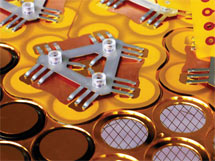

Tuesday - March 9, 2010
SLAC Today is
available online at:
http://today.slac.stanford.edu
In this issue:
EXO Takes Clean to an Extreme
Welcome, New SLACers!
Special Colloquium Today: The Enterprise of Accelerators
 |
 |
|
Tuesday - March 9, 2010 |
EXO Takes Clean to an Extreme This triangular metal gadget is an "APD Spider." It connects EXO's light sensors—the golden circles—with electronics that allow scientists to read out the data from the experiment's detector. (Photo courtesy of the EXO collaboration.)
Some particle physics experiments require an extraordinary degree of cleanliness and quiet. How far will they go to achieve this? Try etching tools with acid, setting up shop in a deep salt bed, putting equipment on stilts, and choreographing a 2100-kilometer truck ride so not a moment would be lost. Just before midnight on November 3, 2009, a large truck loaded with 40 tons of cargo pulled away from the Stanford University campus. It carried the last shipment of laboratory equipment from Stanford to New Mexico for a high-energy physics experiment that will begin taking data this year. Moving complicated experimental equipment is always a delicate process, but in this case the task was more challenging than usual. The experiment, called the Enriched Xenon Observatory 200, or EXO-200, is designed to look for an ultra-rare phenomenon that could reveal key secrets about the nature of the neutrino. This process is so rare that detecting just a few signals over the course of a year would be a triumph. Scientists have no hope of seeing these faint signals unless they eliminate every possible source of background radiation that could get in the way. Yet sources of radiation are everywhere—from cosmic ray particles that rain down from space to materials as common as copper, everyday tools, ordinary rocks, even the human body. It had taken the 70 scientists and engineers of the EXO collaboration six years to design and assemble their detector—a tank that would hold 200 kilograms of liquid xenon cooled to a very low temperature and heavily shielded by onion-like layers of components. A fanatic degree of cleanliness prevailed at every step. Most of the components were not only assembled in clean rooms, but also shipped in those same clean rooms, shielded and sealed against contamination. Even so, the team choreographed and practiced every move to make sure those containers spent as little time as possible in the open air. Read more in Symmetry magazine... Welcome, New SLACers!SLAC welcomed 10 new staff at last Thursday's New Employee Orientation. They are, from the left: Joshua Turner
Please join us in congratulating our new staff as they embark on their pathway to success at SLAC! Special Colloquium Today: The Enterprise of AcceleratorsToday at 4:15 p.m. in Panofsky Auditorium, Cockcroft Institute Director and Sir John Cockcroft Professor of Physics at the Universities of Liverpool, Manchester and Lancaster Swapan Chattopadhyay will present "To Discovery through Research, Innovation and Service: The Enterprise of Accelerators." The event is free and open to all. |
Events
Access (see all)Announcements
|
|
| | ||
|
|
||
 <%
Response.AddHeader "Last-modified", getArticleDate()
'Response.AddHeader "Last-modified","Mon, 01 Sep 1997 01:03:33 GMT"
'Monday, December 06, 2010
%>
<%
Response.AddHeader "Last-modified", getArticleDate()
'Response.AddHeader "Last-modified","Mon, 01 Sep 1997 01:03:33 GMT"
'Monday, December 06, 2010
%>View online at http://today.slac.stanford.edu/. |
||